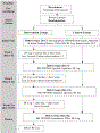Promoting self-management of breast and nipple pain in breastfeeding women: Protocol of a pilot randomized controlled trial
- PMID: 30835887
- PMCID: PMC6481628
- DOI: 10.1002/nur.21938
Promoting self-management of breast and nipple pain in breastfeeding women: Protocol of a pilot randomized controlled trial
Abstract
The majority of women experience pain during breastfeeding initiation with few strategies to manage breast and nipple pain. In fact, women cite breast and nipple pain as among the most common reasons for breastfeeding cessation. To address this important issue, we developed a breastfeeding self-management (BSM) intervention, based on the Individual and Family Self-Management Theory Framework. In this framework, self-management is conceptualized as a process in which women use knowledge, beliefs, and social facilitation to achieve breastfeeding goals. The purpose of this longitudinal pilot randomized controlled trial was to test the feasibility, acceptability, and preliminary efficacy of the BSM intervention with women initiating breastfeeding. Recruitment of 60 women intending to breastfeed occurred within 48 hr of delivery and women were randomized to either the intervention or usual care group. The BSM intervention group received BSM education modules that included information of how to manage breast and nipple pain and self-management support through biweekly texting from the study nurse, and were asked to complete a daily breastfeeding journal. Primary outcomes measured at baseline, 1, 2, and 6 weeks will be used to (a) evaluate feasibility, acceptability, and preliminary efficacy of the BSM intervention, and (b) assess the influence of protective and risk factors of breastfeeding pain (including individual genetic polymorphisms related to pain sensitivity) on process variables for self-management of breastfeeding and breastfeeding pain, and on proximal (breastfeeding pain severity and interference, breastfeeding frequency) and distal outcomes (breastfeeding exclusivity and duration and general well-being).
Keywords: breastfeeding; pain; self-management.
© 2019 Wiley Periodicals, Inc.
Conflict of interest statement
None of the authors have no conflicts of interest to declare.
Figures


References
-
- American Academy of Pediatrics. (2012). Breastfeeding and the use of human milk. Pediatrics, 129(3), 600–603. 10.1542/pes.2011-3552 - DOI
-
- Amir LH, Jones LE, & Buck ML (2015). Nipple pain associated with breastfeeding: Incorporating current neurophysiology into clinical reasoning. Australian Family Physician, 44(3), 127–132. - PubMed
-
- Bandura A (2005). The primacy of self regulation in health promotion. Applied Psychology: An International Review, 54(2), 245–254.
-
- Barnes G, Lethin A, Jackson E, & Shea N (1953). Management of breast feeding. JAMA : The Journal of the American Medical Association, 151(3), 192–199. - PubMed
